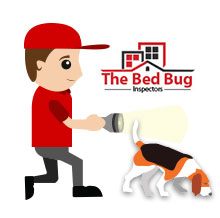Article Contents
Bugs That Look Like Bed Bugs

Bed bugs are an extremely difficult pest to identify. Their nature is to stay hidden. They find the remotest, furthest-from-sight locations to hide until you go to sleep and they can come out and feed on you. And even if they’ve bitten you, their bites are hard to distinguish from other common insect bites, even by doctors.
Making identification even more challenging, there are several bugs that look like bed bugs. So if you think you’ve spotted bed bugs—and even if you’ve checked out bed bug photos on the web to be sure—it’s easy to be fooled.
With that in mind, here’s a list of bugs that look like bed bugs for you to review before jumping to a conclusion. The good news is that none of these bugs feed on humans!
Bat bugs
These bugs look like bed bugs in that they both have broad, flat bodies and wide heads. One difference is that bat bugs bloat after a meal. Another reasonably certain sign that you’ve spotted a bed bug rather than a bat bug is if you saw it in your bed or furniture. Because bat bugs feed on bats instead of humans, they don’t share bed bugs’ habit of make their homes in beds and furniture that’s near humans.
Humans may not feel the bite of a bat bug, though their bite is reportedly more painful than that of a bed bug. Many people develop an allergic reaction to proteins in the injected saliva from the bug. Humans experience varying degrees of immunological reactions to bug bites, but a welt or lump at the site of the bug bite and severe itching are the most common reactions. (Ohio State University)
Poultry bugs (i.e., Mexican chicken bugs)
These bugs look like bed bugs except that they have longer legs and beaks. As with bat bugs, these pests don’t normally live in beds and furniture, preferring instead to live near the fowl they feed on.
Swallow bugs
These bugs look like bed bugs, except that they have long, silky “hair.” These insects will sometimes live in homes when the cliff swallow birds they feed on are migrating.
Carpet beetles

These bugs look like bed bugs in size and shape, but they have wings.
Carpet beetles feed on animal and plant substances such as wool, fur, feathers, hair, hides, horns, silk, velvet, felts and bone as well as seeds, grain, cereals, cake mixes, red pepper, rye meal and flour. Other substances include powdered milk, dog and cat food, leather, book bindings, dead insects, bird and rodent nests, and even cotton, linen, rayon, and jute, especially when stained with spilled food and animal excreta. The larvae cause the damage, crawling from room to room and living behind baseboards and molding, and in heating system air ducts, dresser drawers, carpets, clothing and furniture. (Ohio State University)
Book lice
Psocids, otherwise known as book lice, are frequently mistaken for bed bugs because of their similar appearance to bed bugs in the nymph stage. These insects also do not bite humans.
Dust Mites
These creatures are invisible to the human eye, but they are drawn to beds and, although they don’t bite, they can cause serious allergic reactions. Because these reactions can sometimes be traced to a particular bed, it’s easy to assume that the problem is bed bugs.
Spider Beetles
If you compare a photo of a spider beetle to a bed bug, they don’t look the same. But spider beetles have a bloated, reddish-brown appearance, causing amateurs at bed bug detection to assume they’ve been feeding on human blood. Unlike bed bugs, spider beetles don’t bite humans, so if that’s what you have instead of bed bugs, you can breathe a sigh of relief.
Takeaway
If you suspect you have bed bugs, don’t be fooled by these or other insects. If you’re unsure, professional pest-control specialists trained in bed bug detection can determine whether you need treatment for bed bugs or for something else.
It’s helpful to know which bugs look like bed bugs but aren’t. However, chances are if you find the bugs around your bed or furniture, that they are bed bugs. Unless you can clearly determine it’s another type of bug, you’ll need to call a pest control company that specializes in bed bug detection and removal, because not only is it difficult to be sure you have bed bugs, getting rid of them is in no way a DIY job.
More Bed Bugs Facts
- When Do Bed Bugs Come Out?
- Bed Bug Feces: How Harmful Is It?
- Bed Bug Guide: Steps to Take If You Suspect a Bed Bug Infestation
- Bed Bugs Symptoms
- Where Do Bed Bugs Come From?
- 5 Types Of Bed Bugs And How To Identify Them
- What Are Some Bugs That Look Like Bed Bugs?
- How Long Can Bed Bugs Live
- How Do Bed Bugs Spread?
- The Bed Bug Life Cycle


